Kitchen Design Ideas
February 14, 2016With interior design in general is there is no perfect design, it’s personal and there are so many variables involved that you can easily find 30 kitchens you love. The problem of course is making decisions for every design element.
That said, there are some required (building codes), general and suggested kitchen design tips and guidelines that are important to follow.
Here is an outline of things to consider:
- A. Preliminary Kitchen Planning
- B. Kitchen Cost
- C. Kitchen Layouts
- D. Countertops
- E. Kitchen Colors
- F. Kitchen Styles
- G. Kitchen Seating Design & Features
- H. Kitchen Flooring
- I. Kitchen Storage
- J. Kitchen Islands
- K. Kitchen Lighting
- L. Kitchen Backsplashes
- M. Kitchen Space-Saving Tips
A. Preliminary Kitchen Planning
When planning your kitchen, be mindful of the following:
1. Building codes (varies jurisdiction to jurisdiction);
2. Your budget (establish it before you start seriously planning);
3. Your needs followed by your wants;
4. How your decisions impact home resale value (kitchens can add to your home’s value – but some features increase value better than other features); and
5. If you’re designing the kitchen yourself, tinker with kitchen design software (it’s a lot of fun and it will give you ideas with how to proceed… especially layout).
B. Kitchen Cost
Kitchens are the most expensive room of a house in most houses. That makes sense given all that goes into creating a kitchen you don’t need in other rooms – cabinetry, appliances and countertops.
Nevertheless, the cost of a new kitchen ranges significantly.
1. Cheap kitchen design
On the low end, expect to pay $5,000 to $15,000 for a full kitchen reno if you do much of the work yourself. If you get a designer and contractor involved for all of the work, a new kitchen will set you back at least $20,000 and easily eek up to $30,000.
2. Mid-range kitchen cost
A mid-range new kitchen will cost $30,000 to $75,000. While it’s a mid-range price, this budget will get you a very, very nice kitchen without you having to do any of the work. The average mid-rang kitchen reno is $53,931 (source: Cost vs. Value by Remodeling.com)
2. High-end luxury kitchen cost
The sky is the limit when it comes to spending money on pretty much anything these days. Kitchens are no exception. For a no-holds-barred luxury kitchen in a large space, expect to pay $75,000+. In fact, believe it or not, there are no shortage of homes that have kitchens that cost more than $100,000. The average upscale kitchen remodel cost in 2015 was $113,097 (source: Cost vs. Value by Remodeling.com)
Additional Cost Resources:
- Sources: Kitchen Remodel Costs: 3 Budgets, 3 Kitchens. Houzz.com
- Sources: How Much Does a Kitchen Makeover Cost? Forbes.com
C. Kitchen Layouts
4 aspects to kitchen layouts are:
- Size
- Open vs. Closed
- Layout Configuration
- Kitchen Zones
1. Kitchen Size
It’s hard to choose a size until you’ve actually cooked in kitchens of various sizes. If you’re current kitchen is too small, how much should you expand it? If you’re designing from scratch, how big should you make it?
On the flip side, you can create a kitchen too big. At some point a kitchen is so big you spend more time running around than actually getting food prepared.
- Small kitchen size: <70 square feet
- Average kitchen size: 100 to 200 square feet
- Large kitchen size: >200 square feet [1]
Things to consider when determining the size of your kitchen:
How many people use the kitchen at the same time? Do two or more people jostle around or is it a one-person show?
How many kitchen appliances do you have? Do you like them on counters ready to use or store them?
One great way to hone your kitchen layout is to use kitchen interior design software to create floor plans with your allocated kitchen space.
2. Open vs. Closed
You probably know immediately whether you want an open concept kitchen or more of an enclosed kitchen or a hybrid. A hybrid is a kitchen with dining area included. A fully open concept living space is a larger room with kitchen, dining area and family room (or living room).
Generally, open concept is preferred over closed these days. However, one consideration is if you entertain often and you prefer guests not seeing the kitchen in a chaotic state. Of course the downside to a closed kitchen when entertaining is the cook is cut off from the pre-meal entertaining.
i. Open Concept
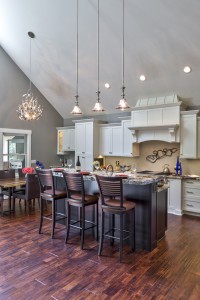
ii. Partially Open Concept Kitchen
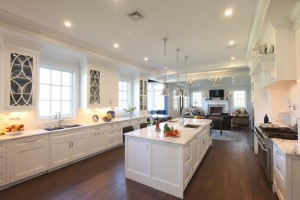
iii. Closed Kitchen
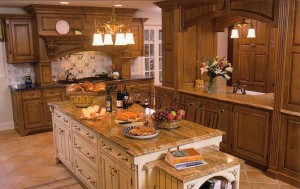
3. Five Main Kitchen Layouts
i. Single-line kitchen (no island)
ii. Single-line kitchen with island
iii. Galley/corridor/parallel kitchen (with or without an island)
iv. L-shaped kitchen (with or without an island)
v. U-shaped kitchen (with or without an island)
Custom layout: Some kitchens buck conforming to typical layouts and come up with unique layouts.
4. Kitchen Zones
Planning your kitchen zones can be simple if it’s a smaller kitchen or more difficult with a large kitchen. The key is to plan the layout based on tasks you perform in the kitchen. While there are universal tasks performed in all kitchens (cooking/washing/prepping/storing) there are tasks you may do that other people don’t typically do (pizza making/baking/cooking with kids, etc.).
Step 1: List your main tasks
They typically are (although you may have additional regular tasks):
Cooking/Oven Use: Ensure you have flat, bare counter space adjacent to the stove/oven for placing hot food. Ideally, you’ll have sufficient space for plating without having to truck hot pans and pots any distance.
Washing: This is simple. Place the main sink close to the dishwasher. Ensure there is ample counter space next to the sink. You also want disposal near the sink (which is a long-standing garbage/recycling placement).
Prepping: If you chop and/or bake, you want counter space close to the refrigerator. Ideally the prep counter space will also be close to a sink for rinsing. One thing to include in the prep zone is a space for a computer (laptop, tablet or something similar) so you can follow recipes. Generally the prep zone is a good place for this because it’s where you prepare your ingredients.
Storing: Every zone should include sufficient storage so that the tools you require are only an arm’s length away. For example, if you have a baking zone, have nearby storage for your baking appliances and implements. The refrigerator/freezer are also a storage units. Their use is enhanced with counter space adjacent to them when pulling out a lot of food or putting in a lot of food (i.e. grocery shopping day).[2]
You may have unique storage requirements such as wine, recipe books, small kitchen appliances, etc. List out your storage requirements and apply to the applicable zone(s).
Additional tasks unique to your home and kitchen operations:
Guest/family zone: This is big if you like cooking with guests and/or your family around. A simple solution is a counter or island bar. You might even consider a sofa off to the side.[3]
Specialty food preparation: Do you routinely prepare types of foods that have a unique process? If so, plan accordingly.
Kitchen appliances: It doesn’t take too many small kitchen appliances to clutter up a kitchen. Be realistic about which ones you want on the counter (only those you use regularly) and those you can store. If you use an appliance regularly, plan a zone around it. For example, if you’re into juicing, creating a small juicing zone near the refrigerator with a sink nearby.
Computers: It’s handy having a computer or iPad in your kitchen for online recipes. If you’re designing a kitchen, seriously consider creating a space for your computer. Generally, the prep zone is best.
Step 2: List everything you need for each task and plan the task zone accordingly.
This refers to appliances, implements and anything else you might need for each zone. Don’t forget counter space, storage, floor space and complementary zone access.
NOTE: I realize zone planning seems technical and overly detailed, but planning out your kitchen zones requires careful thought and planning. Be thorough because proper zone planning can radically enhance your kitchen for you.
Additional kitchen layout suggestions:
Work aisles: If you have the luxury to do so, create wide work aisles. This is a terrific convenience when two or more people are in the kitchen. The minimum width is 42″. If you have multiple cooks, go with 48″ or more.[4]
Counter space is a premium: I’ve never been in a kitchen with too much counter space. One universal requirement with pretty much every kitchen task. This is a huge benefit to large kitchen spaces. While storage is great, more counter space is often better.
Your kitchen’s users’ height: Are you or anyone in your family tall? If so, pay attention to overhead cabinet placement, island height, counter height and lighting.
Doors and openings: If you have swinging doors as part of access to your kitchen (becoming rare these days), take into account the arc of the door if it swings into your kitchen.
D. Countertops
1. How much counter space is best for a kitchen?
The guideline is at least 158″ x 24″ deep with at least 15″ of clearance above.[4] To put that into perspective, that’s just over 13 feet of counter top length for a total of 26.3 square feet of counter top space. Ideally, you’ll have more if you have the space.
One large island that’s 5 feet by 3 feet adds 15 square feet, doubling your counter top space. That explains why islands are so popular.
2. How tall should counters be?
The standard kitchen counter height is 36″ (3 feet).[5] While you might be tempted to veer from this to accommodate your height (I know I’d like slightly higher counters), you must always follow building codes and keep resale value in mind. One way to create a custom counter to fit your height is to build a custom island. Better yet, create a multi-level island for better accommodation. Our island is much taller than 36″ which is very convenient for me.
3. What’s the best counter top surface material?
Granite: Granite is popular and arguably the best. But it’s also expensive. The main benefit other than it looks good, is you can place piping hot pots and pans on it. While it is expensive, it’s good for resale because people like granite. Also, selection is limited since you purchase a slab of stone. You can’t customize the design – you can only keep on looking for a different slab.
Stainless steel: I’m surprised stainless steel countertops aren’t more popular because that’s what is used in commercial kitchens. I also like the look of stainless steel if it’s accompanied by plenty of wood in the kitchen design. The only notable downsides are it’s expensive and it’s a virtual fingerprint canvass.
Concrete: Our kitchen counter is concrete. We like it, but it stains (which can look good if you embrace the worn look). You can also place hot items on it. With current concrete stamping ans staining, you can totally customize the appearance.
Engineered Stone (a.k.a. quartz): Stone counter top that you can customize. It’s also durable. Downsides are it can chip and it’s costly.
Acrylic: This is great because it requires no maintenance. However, it can be burned which makes it look terrible.
Marble: Luxurious and great for baking. But, it’s expensive and stains easily.
Tile: You can customize the design. The downside is it can chip and creates uneven surfaces. I prefer to reserve tile for back splashes.
Wood: Looks amazing and you have one massive cutting board. The downside is it can warp and can be a breeding ground for bacteria. It needs to be cleaned vigorously.
Laminate: It’s affordable and fairly low maintenance. The downside is it scratches, burns, peels and gets worn. Moreover, when it comes to resale, laminate is a drawback.[6]
Granite vs. Engineered Stone Video
This is an informative video about stone countertops.
E. Kitchen Colors
Main color schemes:
Two of the most popular kitchen color designs are natural wood and white as follows:
- All-white kitchen
- All-natural wood tone kitchen
Mix and match: White cabinets with natural wood island (or vice versa), white/wood ceiling, white/wood floor.
Other popular kitchen color designs are:
- Black
- Red, soft yellow and green (often accompanied with white and/or natural wood)
1. White Kitchen with Dark Island
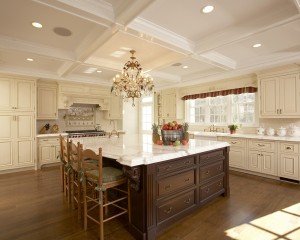
2. White Kitchen with White Island Design
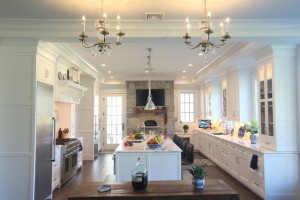
3. Natural Wood Kitchen with White Island
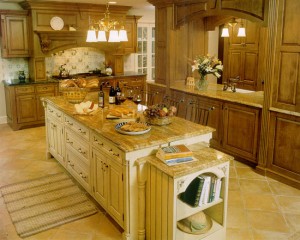
4. Natural Wood Kitchen with Matching Island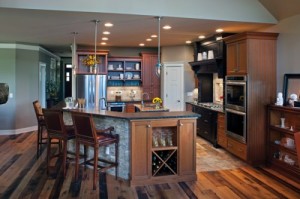
5. Dark Kitchen Design
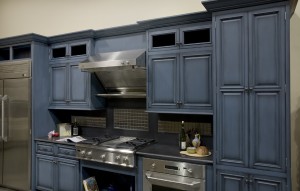
See More Examples of Different Kitchen Color Designs
- Back splashes
- Tile flooring
- Walls (there is often very little wall surface area because of the space cabinets take up, so painting walls red, yellow or green actually adds a small splash of color and doesn’t overwhelm the kitchen in bright colors).
- Island/eat-in counter stools
- Curtains
- Light fixtures
- Floor runners/mats
Main types of wood used in kitchens:
Wood is used for cabinets, islands, paneling, pantries, flooring and ceilings. Some kitchens are literally all wood. Most kitchens incorporate some wood. FYI – in this case I’m referring to a natural wood appearance and not painted wood.
Popular types of wood used for kitchen cabinets (hardwood):
- Alder
- Cherry
- Maple
- Oak [7]
Stainless Steel:
While few residential kitchens embrace stainless steel extensively, many incorporate stainless steel elements such as appliances, some counter top space, sinks, light fixtures, and fixtures.
F. Kitchen Styles
Obviously you want your kitchen design to match that of your home. If your home is in the Craftsman style, you want your kitchen to reflect that. However, in some cases, creating a unique kitchen can work. For example, if you have a contemporary home but would like to incorporate rustic design features in your kitchen, this can work.
The following are examples of different kitchen design styles:
1. Modern Kitchen
2. Craftsman Kitchen
3. Mediterranean Kitchen Example
4. Rustic Kitchen Example
5. Traditional Kitchen Example
6. Cottage Kitchen Example
7. Country Kitchen Example
8. Contemporary Kitchen Example
9. Asian Kitchen Example
G. Kitchen Seating Design & Features
If planning a kitchen today, I think it’s a good idea to include some form of in-kitchen seating/dining placement. There are 4 ways to go about this.
Kitchen island: The island can be one level or two levels. If two levels, it can be an elevated counter or lower dining table. Some large kitchens have two islands with one dedicated for eating/guests. Kitchen islands with seating is a great idea.
Peninsula counter: Generally, peninsulas with an eat-in counter is designed with an elevated counter lined with stools.
In-kitchen dining table: This would be in an open concept or partially open concept kitchen with dining space. Moreover, the table and chairs can be inside the kitchen or outside of the kitchen area, but in the same room.
Not only do these features offer in-kitchen dining which can be convenient, but they also offer places for guests and/or family to sit and converse with the cook(s).
If building a custom island is out of the question, consider buying a portable kitchen island or cart.
H. Kitchen Flooring
Kitchen flooring is important because like many aspects of a kitchen, it serves both aesthetic and functional purposes.
Commonly used kitchen flooring materials are:
Hardwood: Looks great, easy to clean (as opposed to carpet). Downsides are it’s expensive and wood wears (but the worn look isn’t necessarily a bad thing). It’s also excellent for resale value because like granite, people love hardwood floor.
Laminate: Laminate is popular because it offers a hardwood-appearance for less money. Higher quality laminate is also durable.
Tile: Tile floors are popular in warm climates because they help keep a home cool. They’re also easy to clean. You can easily customize the design and color scheme. The downside is it can chip and requires some maintenance.
Carpeting: I’ve seen some kitchens with carpeting, but it’s not ideal. Carpet stains and is difficult to clean. The plus side is it helps muffle noise and is warm for your feet.
Concrete: Durable, customizable and can look great. The downside is it’s cold and hard. Forget about that glass dish when you drop it because it’s a goner. One solution for the cold-on-the-feet problem is to include radiant heating. We have this in our lower level concrete floor and it works great.
Cork: You don’t have to be a wine connoisseur to implement a cork floor in your kitchen. It’s very durable and softer than hardwood and laminate.
Linoleum: Low cost and durable. Downside is it’s not the most aesthetically pleasing.
Bamboo: Looks great (like hardwood). While costly, it’s slightly less than hardwood. Long-lasting and durable.
Flooring accessory: Runners – these can protect your floors in high-spill areas (below the sink), add color and create a softer surface in places you stand for longer periods of time.
Since our coverage of kitchen flooring merely scratches the surface, we suggest you check out the Kitchen Floor Buying Guide by HGTV Remodels which provides more details on each type of floor.
I. Kitchen Storage
Kitchen storage is important. It includes cabinets, drawers, refrigerator/freezer, pantry and possibly specialty item storage.
Kitchen storage planning must be planned in conjunction with work zone planning because storage of appliances and implements are integral to your work processes in the kitchen.
Cabinets
Kitchen cabinets are defined by having swinging or sliding doors. They’re on the floor (36″ in height) and some kitchens include upper cabinets as well (either suspended or attached to the wall).
There are 3 main cabinet buying options:
- Stock: Ready-Made. Just buy it and install it (lease expensive).
- Semi-Custom: Menu ordering system – can customize within parameters.
- Fully Custom: Design it and get it built from scratch (most expensive).[8]
Popular types of wood used for kitchen cabinets (hardwood)[7]:
- Alder
- Cherry
- Maple
- Oak
White and black cabinetry is also popular (and looks great).
Types of cabinets:
- Base cabinets: These sit on the floor and are 36″ tall.
- Wall cabinets (upper cabinets): Usually attached to wall, but in some kitchens are suspended from a ceiling.
- Tall cabinets: Floor-to-ceiling (or nearly so). Also referred to as a pantry.
- Islands: Island often are one large cabinet system.
Cabinet Doors
Since the doors are the most visible, they largely make up the aesthetic aspect of your kitchen cabinets. Four main types of cabinet doors are:
- Slab doors: Flat pieces of plywood with a veneer.
- Plank doors: Flush to the cabinet opening – often routed with decorative patterns.
- Frame-and-panel doors: The door is made up of a frame around a panel. The frames may be decorative.
- Frame-only doors: Frame doors holding glass pane. I often refer to these as glass-faced cabinets.[9]
Kitchen Drawers
Kitchen drawers are a must-have storage feature for smaller items such as utensils, small kitchen implements and other items.
When designing your kitchen, you can use drawers sparingly or extensively. You can use small drawers or create huge drawers. Our kitchen design incorporate many drawers, some of which are 36″ wide and 10″ tall. These are large storage drawers.
Key advantage to drawers: easier to access
Key disadvantage: Less storage capacity. Yes, you can have large custom drawers built, but at some point they become unwieldy (I know because we have exceptionally large drawers). Moreover, drawers can’t hold as much weight as well crafted cabinets because shelving in cabinets (especially the lower level) can hold more weight. The bottom of a draw has little or no reinforcement.
This is why a mix of drawers and cabinets is ideal for kitchen storage.
Pantries
There are 2 types of pantries:
- Tall cabinet, free-standing (or built-in) pantries
- Pantry rooms
If you have the space and budget, a pantry room can be a huge storage convenience because it can be a room with nothing but shelving. However, most kitchens don’t have a pantry room; instead pantries are tall standing cabinets with doors.
If you’re really fortunate, your kitchen with have both types.
Free-standing pantry:
Placement: because it stores food, you want it easily accessible to your prep area zone.
With respect to types of pantry wood, doors, etc. see our cabinets section above.
Pantry Rooms:
Having a pantry room is like having a walk-in closet. When it comes to designing your pantry room, the focus should be on storage capacity. Will you store primarily food or other items? Do you need space to store large items or mostly small items? Think about what exactly you’ll be storing.
Other pantry room design considerations:
- Accessibility from the kitchen
- If it has a door, think through the door’s arc and how it will encroach on your kitchen or inside the pantry. Alternatively you can use a sliding door.
- Will the design match the kitchen or will you decide to save money and use less expensive materials?
- Will it serve purposes other than being storage.
- Research custom storage options – racks, organizers, etc. There are more options than just shelves for creating a more efficient storage room.
J. Kitchen Islands
Many kitchen islands create more counter space and more storage space. They really are a terrific way to enhance a kitchen as long as sound kitchen island design is used.
Storage islands can be viewed as a large cabinet. Some include drawers and cabinets. It’s a large item to design.
3 types of islands:
- Permanent: Built into the floor
- Free-Standing: Not permanently attached to the floor.
- Mobile: Island/butcher block on wheels.
Permanent Island Design… You can:
- Match it to your main kitchen cabinets
- Distinguish it with a contrasting color. For example, if you have white cabinets, get a dark brown island (or vice versa).
- Create multiple levels – work space countertop, dining counter or lower dining table.
Beyond that, the sky really is the limit with how you design your kitchen island and the features you include. Look at each island carefully because the range of ideas is considerable.
Specialty storage ideas:
- Wine rack
- Computer placement/Television
- Bookshelves
- Kitchen appliance storage for easy access (i.e. microwave, coffee maker, juicer, toaster, blender, etc.)
- Suspended pot rack
- Large bowls (stock pots, mixing bowls)
K. Kitchen Lighting
Kitchen lighting sets the mood of any kitchen. It’s an important design element.
The first consideration is natural light. The more, the better. However, the trouble with natural light is the more windows you have, the less space for upper cabinets.
One way to add more natural light is with skylights. Of course, skylights are only a practical option when there isn’t a second floor above the kitchen.
With respect to kitchen lights, you have many options, which is great, but it also makes decision making difficult.
The following are types and photo examples of kitchen lighting (links take you to homestratospheres.com):
L. Kitchen Backsplashes
One of my favorite kitchen design approaches is a fairly neutral design with respect to floor, cabinets, countertops and ceiling but then using the backsplash to add the color.
I’m not the only person who likes this approach; it’s very popular.
The main backsplash materials include ceramic tiles, glass mosaic tile or stone. Some kitchens use a combination, but I prefer sticking with one material throughout.
What is the backsplash?
The backsplash is the wall above countertops… often the wall space between lower and upper cabinets. It’s also the wall area above a stove and below the hood (assuming the stove is against the wall).
Why do you need a backsplash?
In addition to enhancing design, backsplashes perform an important function. It protects the wall. It can get messy in a kitchen, especially in the sink and stove areas. The backsplash protects walls from “splashes” of water, grease, food, liquids and whatever else is going on.
Partial or full coverage?
If you can, by far the best approach with a backsplash is to extend whatever material you’re using from top to bottom. That means from the countertop to the base of the upper cabinets. Not only does this provide fuller protection, but it looks much, much better.
M. Kitchen Space-Saving Tips
Not too many people complain about having too much counter space and storage. In fact, shortage of counter space and storage is a big problem in today’s kitchens.
Fortunately, there are some very simple ways you can improve both.
1. More Counter space Tips
Install a kitchen island. Even if it’s a small island, it will provide another work station plus provide storage underneath.
Place the microwave in a built-in cabinet. Microwaves take up way too much counter space. If you can, place it in a cabinet in the kitchen. If you use the microwave often, place it in a convenient location. If you seldom use it, don’t place it in premium cabinets spots.
Sufficient space between counters and upper cabinets: You want enough space for small kitchen appliances you choose to not store such as a coffee machine. Alternatively, buy kitchen appliances you place on the counter that are small enough to fit directly beneath upper cabinets.
2. More Kitchen Storage
Get a pantry: We have a pantry and it’s amazing. It’s a walk-in-closet for the kitchen. The amount of dry food we can store in it is amazing and it’s not that large in square feet. The entire room is shelving from floor to ceiling.
Pot racks: Pot racks look great and keep your big pots out of cabinets.
Deeper cabinets: We live in a home built in 1983. We used to live in a newer (but smaller home). One thing we noticed in our current home (built in 1983) is that the kitchen cabinets are not as deep as where we used to live.
If you’re doing a kitchen renovation, get deep cabinets so you have more counter space and more storage. We miss the depth of our former cabinets.
Thanks to Catherine Sherwin at
Homestratosphere.com for the great detail of into.